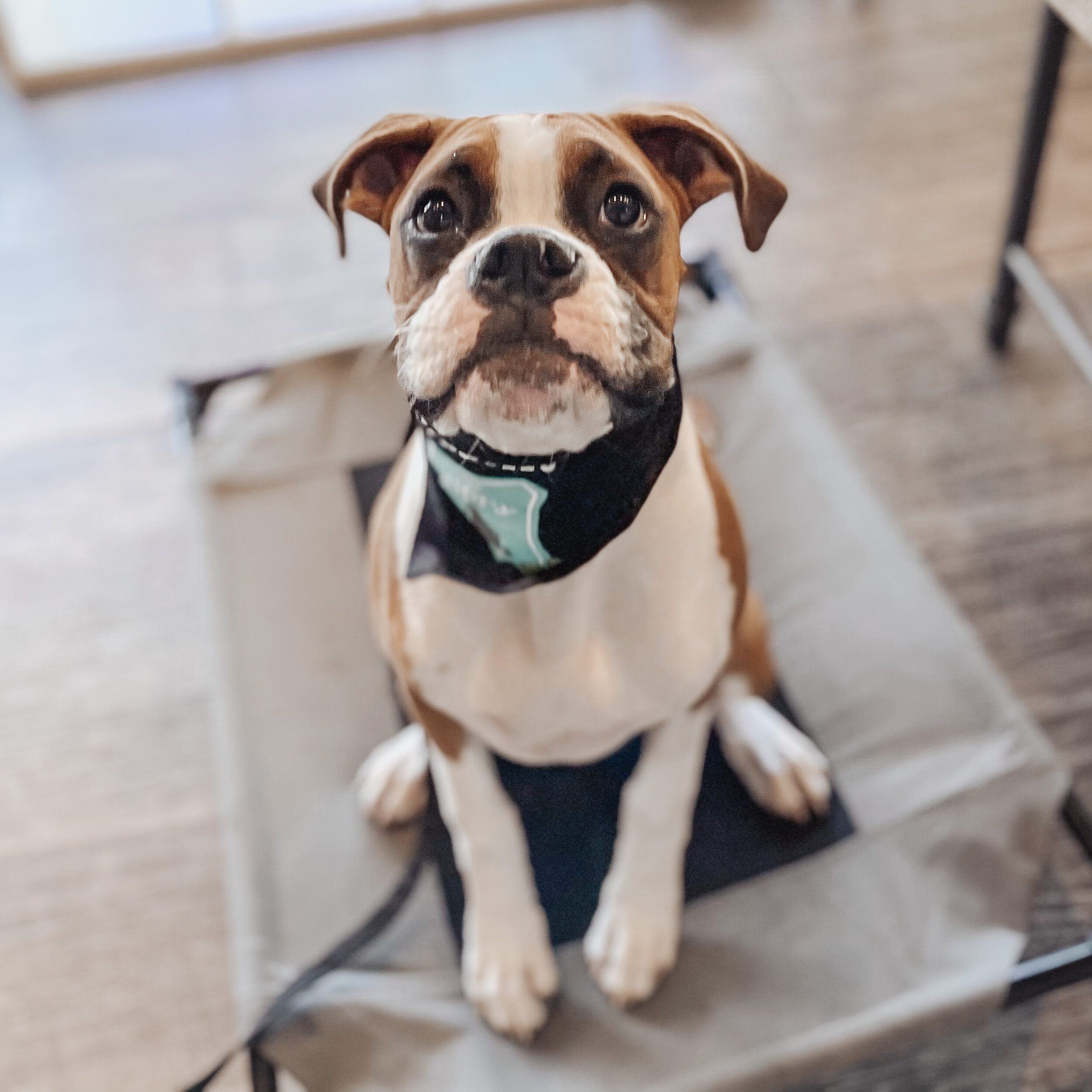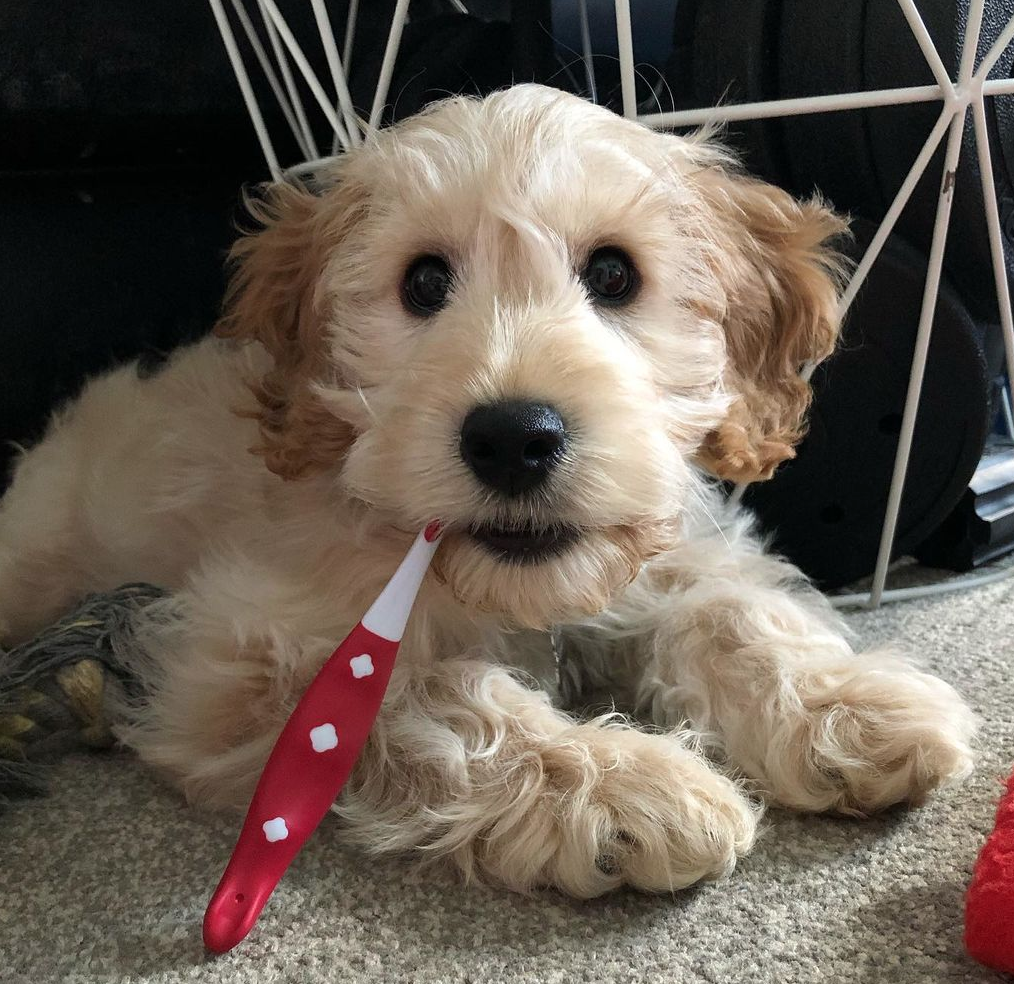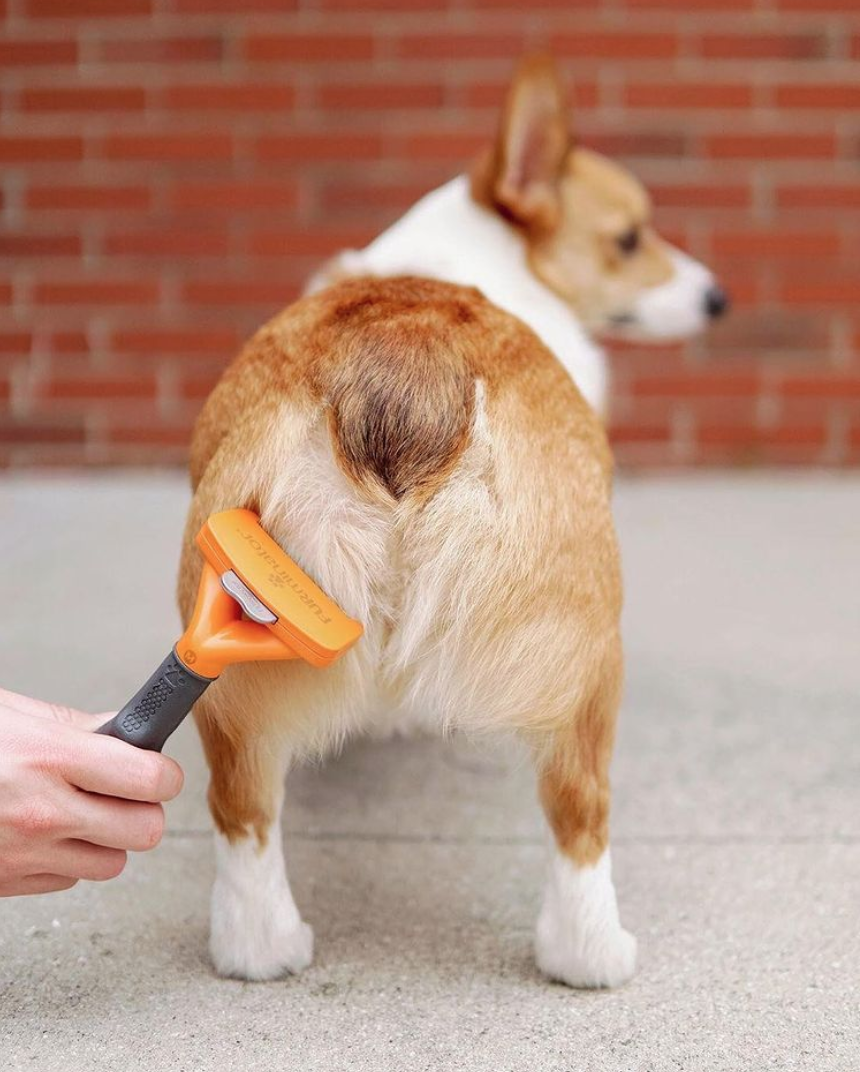Just like puppy training, start off grooming your puppy with small introductions as soon as possible to help them feel comfortable and enjoy the experience!
The Puppy Academy student, Ripley!
Grooming your puppy includes anything from bathing, coat brushing and trimming, nail clipping, ear and paw cleaning, to teeth brushing, and everything in-between! The sooner you are able to start introducing your puppy to the sensations, motions, and tools included in these processes, the easier they will get used to it and be comfortable with the process, and make your job — or your groomer’s — much smoother!
Before attempting to groom your puppy, we recommend that you get your puppy at the right energy level first! It is far easier for you to brush your puppy’s teeth, their coat, or trim their nails if they aren’t wriggling around in your lap! These sessions are easiest done at the end of the day when your puppy is winding down for the night, or after a vigorous play session where they've exerted some good energy first! When you're ready, take a few minutes to hold your puppy in your arms and have some pieces of food or treats handy. While holding your puppy, start to give them a few pieces of food or treats to help them settle down if needed. Some puppies with calmer disposition can ease into that position quickly but other higher-energy puppies might need a firmer hand-hold and calmer energy on your part in order to settle down.
Before you jump ahead, have you introduced your puppy to basic handling? Since grooming is such a hands-on experience, it’ll be far easier for the both of you if you spend a little extra time teaching your puppy that getting their legs, paws, back, stomach, tail, and ears touched is totally normal! But if you’ve done that already and think your puppy is calm, collected, and ready, keep reading to learn how to introduce these basic grooming routines!
Introduce Your Puppy to Teeth Brushing!
@harley_cockapoo20
Start caring for your puppy’s teeth from an early age to help them avoid developing dental disease later in life! If you’re nervous about tackling teeth brushing, we have a method to make it painless for you and enjoyable for your pup!
Teeth brushing for many new puppy owners can be a two-person job. One of you will hold onto your puppy, while the other brushes. Let your puppy familiarize themselves with the toothbrush first. With your puppy in your lap, show your puppy the toothbrush, let them sniff, and even let them lightly chew on it. Doing this helps them feel comfortable with having the brush in their mouth and the feel of the bristles. Some puppies might feel a little unsure of the toothbrush so a good way to work them up to a regular dog toothbrush is to use a rubber finger brush. Use your finger to simply massage your puppy’s gums and let them get used to that sensation.
We recommend that you use dog-specific toothbrushes and flavored toothpaste. The flavored toothpaste feels more like a treat for your puppy than getting cleaned! Put a bit of toothpaste on the brush and let your puppy lick it. While your puppy is engaged, take your free hand to hold onto your puppy’s muzzle and carefully lift up their jowl so your partner can then quickly focus on brushing your puppy’s teeth. You may only be able to get in a few brush strokes at a time on each side but the goal here is more to get your puppy comfortable with this activity first. Dog toothpaste isn't actually necessary to clean your pup's teeth; the bristles of the toothbrush are good enough to break up any food residue sitting by the gums and avoid tartar build-up. But using it, in the beginning, can definitely help your puppy get more comfortable with the process faster!
Pro-tip: While brushing your puppy’s teeth, it’s important to remain calm and keep your energy low. In doing so, you’re helping your puppy understand that this situation isn’t anything to be nervous about and by maintaining a calm demeanor you’ll help your puppy settle down and feel comfortable with getting handling. Don't rush this process either! On the first couple of practice sessions, you may only be able to get one tooth brushed or even a lick of the brush. That's ok! Try to end on a good note every time, and just pick it up the next day. It can take several weeks of frequent practicing before you are able to brush their entire mouth.
Introduce Your Puppy to a Brush!
@thecorgi.bear via @furminator_inc
Depending on the size of your puppy, find what works best for you to hold or handle your puppy when brushing their coat. For small-breed puppies, holding them on your lap can work but for large-breed pups, you might find it easier to have them in a Sit or Down in front of you on the ground. You might even find it easier to enlist the help of your partner again until your puppy learns to settle down during a brushing session, especially if you have a more wriggly puppy!
Slowly, take your puppy’s brush and start to brush down their back. You might only be able to get in a few brush strokes before your puppy starts to get curious and want to chew on the brush. If this happens, stop brushing your puppy and say your marker word “No”. If your puppy stops chewing on the brush, give them a bit of food or treat, say the marker “Good” and then continue brushing. Don’t be discouraged if you can’t fully brush your puppy in the first session! You might notice that after a few minutes, your puppy is starting to wiggle away and that’s totally normal. Puppies have short windows of time, especially if they are very young, in which they want to be held and handled before they are ready to do something else.
Pro-tip: Keep your brush strokes light on your puppy’s coat. You don’t want to feel your puppy’s skin under the brush as that sensation can be very strange and uncomfortable the first few times for your puppy. Softer strokes will help your puppy ease into the feeling of getting brushed and eventually you can really start to get closer to their undercoat and skin.
Pro-tip: Start with short brushing sessions that range anywhere from three to five minutes long and focus on a particular section, such as your puppy’s back, to brush. You don’t have to try and brush your puppy’s entire body at once! Each section will take time for your puppy to get used to feeling the brush, especially sensitive areas like the legs, paws, and belly.
Get Your Puppy Used to Nail-Trimming!
@cascadesummitvets
If you want to trim your own puppy’s nails and not have to rely on a groomer to do it for you, we have a method to make it easy and comfortable for you and your puppy! Nail trimming can be really challenging for some new owners so start as soon as you bring home your new puppy to help desensitize them to the nail trimming tools and getting their paws handled. In the beginning, break up your nail trimming sessions a few times during the week. Your goal will be to work on a couple of nails, maybe a whole paw if your puppy is comfortable enough, before being able to complete a full nail trimming in one sitting.
Start introducing your puppy to the nail trimming tools, whether you choose to use a clipper or Dremel, with food or treats! For the clipper, have the tool near your puppy’s paws and feed your puppy some food or treats. Let them sniff the clipper to familiarize themselves with it, then gradually start to take your puppy’s paw and tap the nail clipper to their nails. Throughout this process, continue to feed your puppy, marking the behavior with “Good” to help them learn to feel comfortable around the tool.
With the Dremel since it produces a whirring sound when in use, turn the Dremel on and just set it next to your puppy. Reward your puppy with food or treats and mark the behavior with “Good”, and let your puppy sniff and listen to the Dremel. Next, start to hold your puppy’s paw in one hand while the Dremel is on, and then say “Good” and reward your puppy. You can take a step further and using the back of your Dremel, tap your puppy’s nails, say “Good” and reward them.
For the first few sessions, don’t expect your puppy to immediately take to getting their nails trimmed! The reality for some puppies is that they may only start to feel comfortable after a few sessions of just being exposed to the tools before moving on to getting their paws grabbed and nails tapped. Every puppy is different and has varying thresholds of tolerance so take your time with this one, remain calm even if your puppy wriggles or tries to nip at the tools, and work on small increments at a time to help desensitize your puppy. The outcome of this hard work now will pay off in a lifetime of easy, quick, and stressless grooming sessions.
Pro-tip: We recommend that you start with the lowest setting for the lowest sound, then moving to the highest setting to increase the sound, only if your puppy shows that they are comfortable at the lowest setting first.
Bathing Your Puppy!
Depending on your puppy’s coat, you might bathe your puppy more frequently or less but we suggest that you research your puppy’s breed for their specific coat care needs! As a general rule though when it comes to young puppies, bathing your puppy should be kept to a minimum since their skin and coats are still developing and sensitive. The natural oils in a puppy’s coat actually help to keep it clean and soft, so shampooing your puppy too often can strip them of those natural oils. You can use conditioner on your puppy but we recommend holding off on shampooing in the beginning unless they are really dirty and need it.
But you do want to start to teach your puppy to feel comfortable with getting bathed, so how do you do that if you can’t bathe them that often? You can start each week by introducing your puppy to the tub (or sink, or wherever you choose to bathe your puppy!) and some lukewarm water at least once per week. During their bath time, let them just get used to standing in a few inches of water without the faucet or sprayer running. The reason for that is some puppies can get a little surprised by the sound and pressure of the faucet and sprayer, so using a cup or bucket to pour water over them is much easier to help them get comfortable with baths. It helps to wash your puppy's entire body first, keeping the head dry until the very end. Avoid getting water directly into their ear canal, and be prepared that they may have some after-bath zoomies which can including rubbing their head and fur to get rid of excess water!
Pro-tip: For bathing and all other grooming sessions, if you are able to get the help of another person, don’t hesitate to ask for help! It makes grooming far easier if one of you can hold and feed your puppy, while the other can brush, trim nails or bathe. If employing another person just won’t work in your situation, get creative! Use your puppy’s leash to help keep them in place, and when it comes to bath time, there are plenty of suction silicone pad options where you can apply peanut butter, for example, to keep your puppy entertained while you bathe them! And if you're planning on using a hairdryer, remember to practice introducing your puppy to it slowly as well, similar to how we explained earlier introducing the Dremel. But, be mindful of the heat settings and don't touch your puppy directly with it while it is turned on or hot!
Remember, getting your puppy used to grooming takes a few weeks of patient, small steps! Introduce them to the tools, let them feel comfortable getting touched by the tools, and use high-value food or treats to help your puppy learn that grooming is a positive experience! The more sessions under your belt, the quicker and less cumbersome they will become until they are just another regular activity in your puppy’s routine!
Check out these blogs related to puppy training and more!
Puppyhood Made Easy for New Owners: How to Prevent Nipping, Chewing, and Jumping!
Puppyhood Made Easy for New Owners: Puppy Handling and Harness Tips!
Puppyhood Made Easy for New Owners: How to Deal with Separation Anxiety in Puppies!





